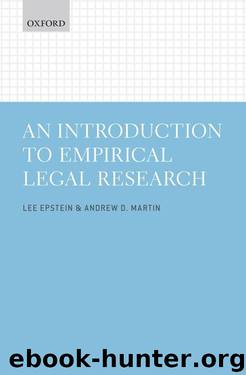An Introduction to Empirical Legal Research by Lee Epstein & Andrew D. Martin

Author:Lee Epstein & Andrew D. Martin [Epstein, Lee]
Language: eng
Format: epub
ISBN: 9780199669059
Publisher: Oxford University Press
Published: 2014-08-14T03:00:00+00:00
We also might choose to write the confidence interval in the following way: 95% CI : [163.71, 216.55].
How do we interpret this range of values? We could say this: In our sample, the mean sentence length is 190.128 months. If we were to draw 100 samples of sentence length, in 95 the mean length would be between 163.71 and 216.55. We would not say that the interval [163.71, 216.55] contains the parameter with 95% probability. Though tempting, this would be incorrect. Population parameters—the things we’re interested in learning about—are fixed, unknown quantities. Statistics, on the other hand, are random variables because they are computed from data that are randomly selected from the population. Every sample will yield a slightly different statistic. We construct confidence intervals such that in some percentage of samples the interval will contain the true population parameter.
To see how this works, consider Figure 7.3. Here we have a population with a known mean μ = 240. We randomly draw 50 samples from this population, each of size n = 50. We then compute and plot the 95% confidence intervals for the population mean. If you look carefully at the figure you’ll see that 47 out of the 50 confidence intervals contain the known population parameter. This is just what we’d expect; in about 95% of the 50 samples we’ll find the population parameter. For any given sample the probability that the confidence interval contains the population parameter is either zero (it doesn’t) or one (it does). As an analyst it’s impossible to know for certain because we never know what the population parameter is. The other thing to notice is that the confidence interval is different for each sample. Confidence intervals are random variables too because we compute them from random samples of data.
Figure 7.3 Confidence intervals for the population mean from 50 random samples of size n = 50. The population mean μ = 240 is shown with the vertical line.
Download
This site does not store any files on its server. We only index and link to content provided by other sites. Please contact the content providers to delete copyright contents if any and email us, we'll remove relevant links or contents immediately.
Every Landlord's Legal Guide by Janet Portman & Stewart Marcia & Ralph Warner(1567)
Philosophy of law a very short introduction by Raymond Wacks(1542)
How Innovation Works by Matt Ridley(1535)
Writing to Win: The Legal Writer by Steven D. Stark(1497)
Drafting Contracts: How and Why Lawyers Do What They Do, Second Edition by Stark Tina L(1404)
Law Man by Shon Hopwood(1351)
Nolo's Essential Guide to Divorce by Emily Doskow(1328)
So You Want to be a Lawyer by Lisa Fairchild Jones Esq(1327)
Nolo's Encyclopedia of Everyday Law: Answers to Your Most Frequently Asked Legal Questions by Shae Irving & Nolo (Editor)(1252)
Garner's Modern English Usage by Bryan Garner(1180)
Profit From Your Idea: How to Make Smart Licensing Deals by Attorney Richard Stim(1163)
Nolo's Encyclopedia of Everyday Law: Answers to Your Most Frequently Asked Legal Questions by Shae Irving; Nolo (Editor)(1141)
Best Practice by J.A. Armstrong(1128)
Introduction to the study and practice of law in a nutshell by Kenney F. Hegland(1123)
Data Protection: A Practical Guide to UK and EU Law by Carey Peter(1067)
International Trade and Business: Law, Policy and Ethics by Gabriël Moens & Peter Gillies(1058)
Everybody's Guide to Small Claims Court by Attorney Ralph Warner (Nolo)(968)
Credit Repair by Loftsgordon Amy(968)
Researching the Law: Finding What You Need When You Need It (Aspen Coursebook Series) by Amy E. Sloan(961)
